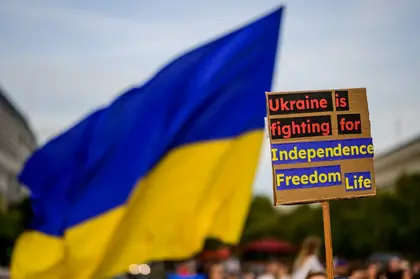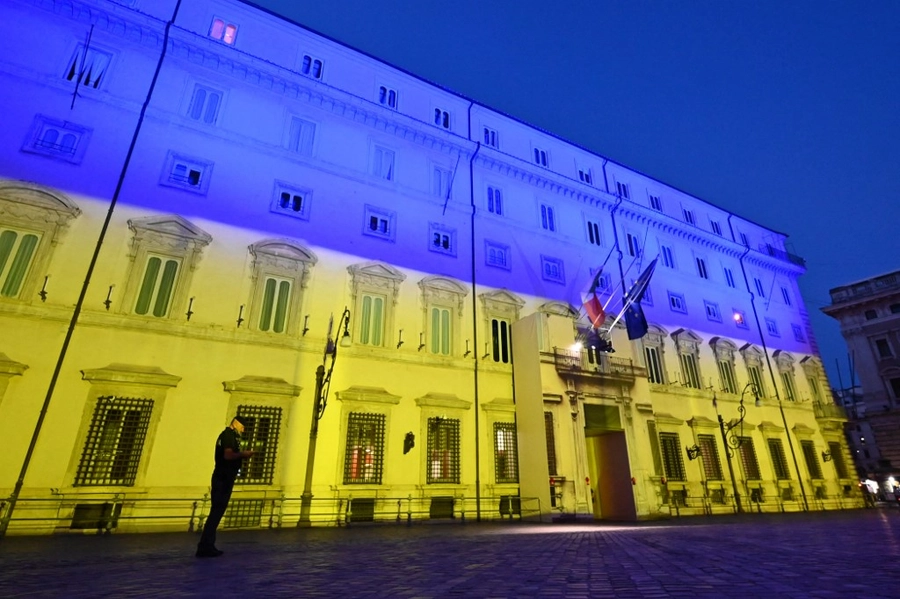The national blue-and-yellow flag is a strong symbol of Ukrainian identity. It could be seen prominently during the Revolution of Dignity in 2014 and in Russia’s war against Ukraine.
Ukraine’s Flag Design
While the flag appears simple at first, with just two main colors, there are stringent guidelines in Ukraine regarding its production and color accuracy.
JOIN US ON TELEGRAM
Follow our coverage of the war on the @Kyivpost_official.
Technical Specifications
Ukraine’s national flag consists of equal parts of blue and yellow, as established in Article 20 of the Constitution of Ukraine — “State Flag of Ukraine [is] exacted from two isometric horizontal bars of dark blue and yellow.”
The Ukrainian government also established strict guidelines on the production and procurement of the Ukrainian national flag for official use.
- The flag should be made from satin, and the front and back sides must be identical.
- The required ratio of the flag is 2:3.
- The flags should be made using the following dimensions, with no more than two percent deviation:
- 160 x 240 cm for a standard coffin
- 200 x 300 cm for a zinc coffin
According to the DSTU 4512:2006 technical specifications that govern the flag design, here are the color values in RGB:
Trivia
Despite maintaining the same design since the founding of modern-day Ukraine in 1991, the flag colors experienced subtle revisions over the years.
In 2006, a darker shade of blue was introduced to the flag, giving it its current look.
The colors of the Ukrainian flag have been projected onto buildings all over the world since the launch of Russia's full-scale invasion. In this picture, they grace the Chigi Palace, site of the Italian government. PHOTO: AFP.
Meaning of the Ukrainian Flag
The colors of the flag have symbolic significance. The blue symbolizes the blue of the sky above the yellow, an endless field of wheat. Ukraine has some of the most fertile soil on the planet and is called the “Breadbasket of Europe.”

China, EU, Ukraine Leaders Take Davos Stage Under Trump Shadow
It is a major supplier of wheat globally — a status that has been threatened by the ongoing invasion and directed attacks against Ukraine’s grain warehouses.
The flag also symbolizes Ukrainians’ sense of national identity during Russia’s full-scale invasion. Even under occupation, Ukrainians cherish their flag, as witnessed by footage of a Kherson resident who retrieved the flag he’d kept hidden under stone slabs, following liberation from Russian occupation in his part of the region.
Today Ukraine celebrates National #FlagDay. To mark it, we want to bring back a video of Kherson woman unearthing 🇺🇦flag on November 9th 2022, the day when Kherson was liberated after 8 months of occupation. She buried it under paving stones when Russian troops occupied the city. pic.twitter.com/wbXrLi6YLG
— FeministsUA (@FeministsUa) August 23, 2023
History of the Ukrainian National Flag
The flag of Ukraine has seen multiple changes over the course of its history and has borne witness to Ukraine’s turbulent path to independence.
Supreme Ruthenian Council: 1848–1851
The first modern use of blue and yellow to represent the Ukrainian identity can be traced back to Ukrainian revolts in the Austrian empire in 1848, when the Supreme Ruthenian Council, a political body based in Lviv that advocated for the use of Ruthenian languages, adopted the colors in its banner.
Early independence: 1917–1921
At the onset of the Russian Revolution in 1917, the blue and yellow flag was flown in Petrograd (current day St. Petersburg) during a mass demonstration, and it was flown for the first time in Kyiv later that month.
The Ukrainian People's Republic, the first modern Ukrainian state, was founded in 1918, and it marked the first use of the blue and yellow colors as the national flag.
Soviet Ukraine: 1922–1991
During the Soviet era, when Ukraine became the Ukrainian SSR and was incorporated into the Soviet Union, the use of Ukrainian colors, along with the trident (“tryzub” in Ukrainian) – the Ukrainian coat of arms, were banned by the authorities to suppress the Ukrainian independence movement.
To further suppress the Ukrainian population, the Soviet state also orchestrated a famine, the “Holodomor,” during the 1930s that led to the death of millions, an act that has been officially recognized by many countries and international bodies including the EU, Council of Europe, US, UK, and others.
The red flag had been used throughout the history of the Ukrainian SSR with differing styles. From 1939 onwards, and until the dissolution of the Soviet Union, the national flag of Ukraine had a hammer and sickle, maintaining a uniform style with other Soviet states.
Ukrainian Insurgent Army
During World War II, the Ukrainian independence movement was spearheaded by the Ukrainian Insurgent Army, a partisan group engaged in guerrilla warfare simultaneously against Nazi Germany and the Soviet Union, until the group was disbanded in 1949. The army adopted red and black colors on its banners.
Interbellum and Reichskommissariat Ukraine
The Reichskommissariat Ukraine was a civilian regime under Nazi occupation. Under the regime, it is believed that millions of Ukrainians — both of Jewish and non-Jewish descent — died because of a systematic genocide against the Ukrainian population.
The Reichskommissariat Ukraine did not have its own flag, instead, the governing bodies used the flag of the Third Reich.
Return of the National Flag
Ukraine was able to revive its national identity during the reforms of the late Soviet era, and the blue-yellow flag was flown in Stryi, a city in western Ukraine, for the first time under Soviet rule, in 1990.
Ukraine declared independence on Aug. 24, 1991, and its flag was raised on Sept. 4 over Ukraine’s parliament, signifying a new, independent Ukraine after long years of struggle.
You can also highlight the text and press Ctrl + Enter











